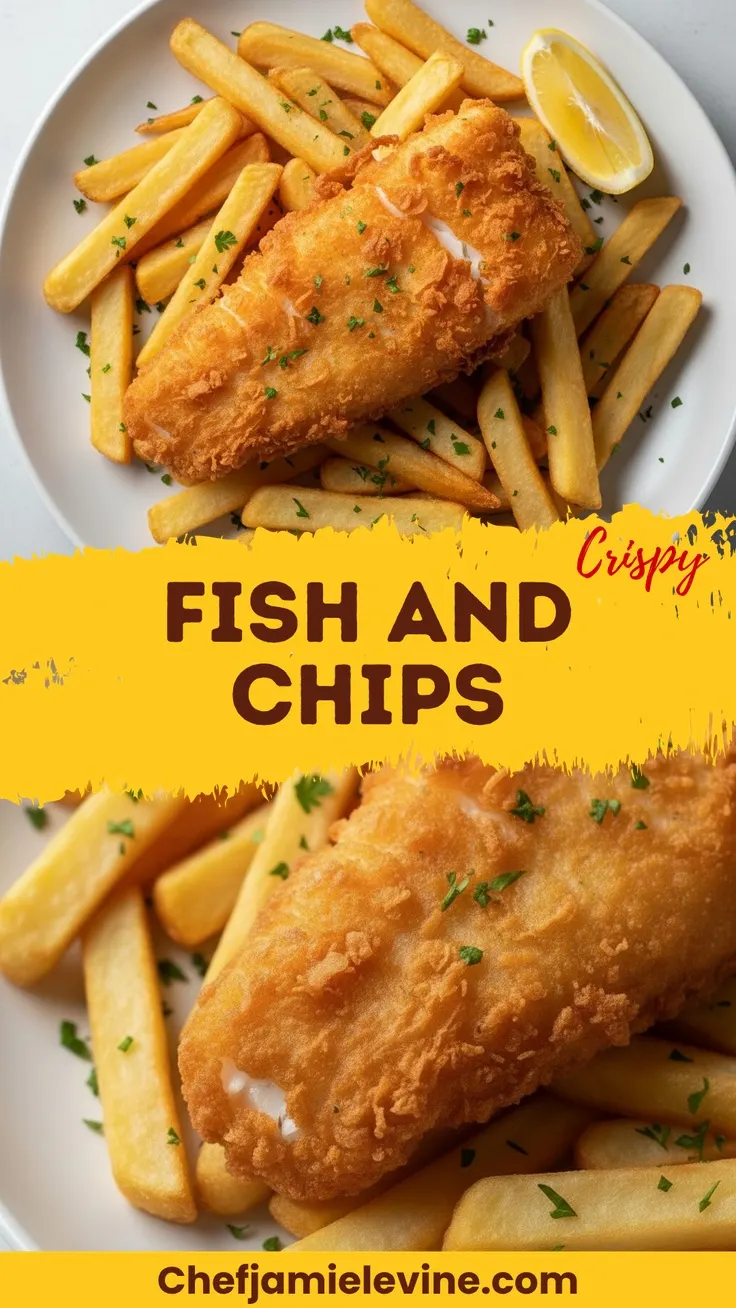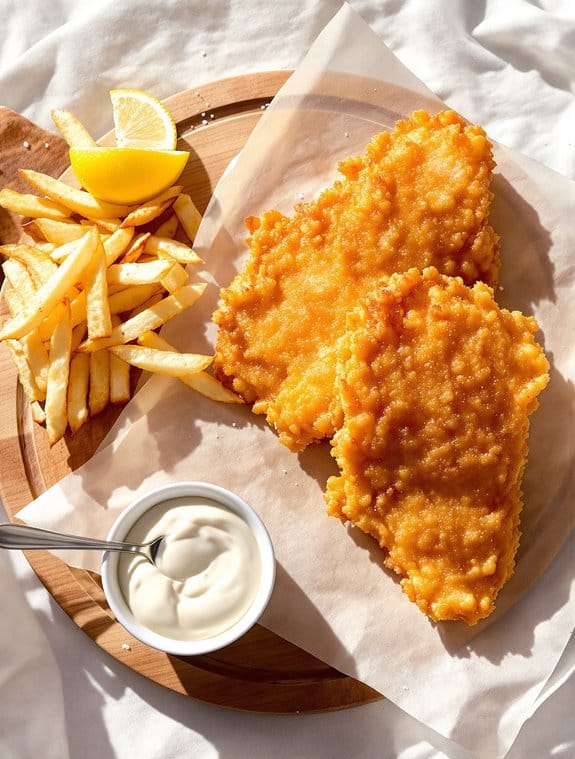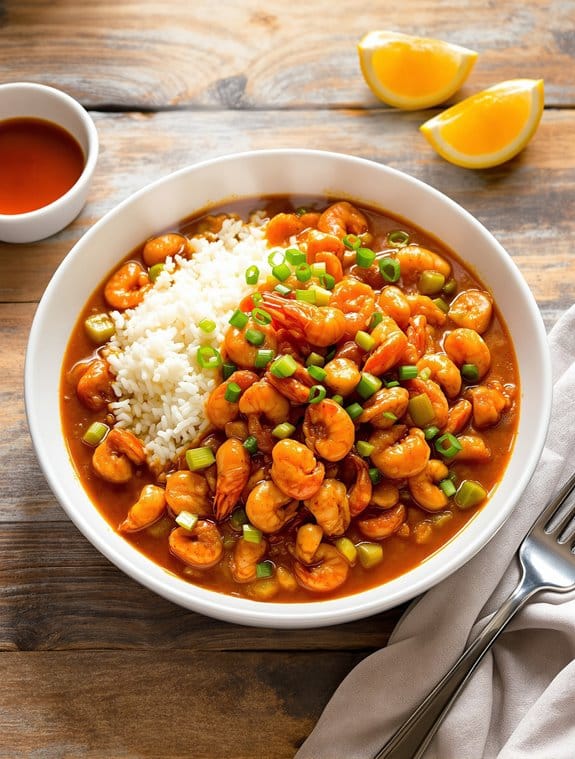Why You’ll Love this Golden Fish and Chips
When you bite into these perfectly golden fish and chips, you’ll understand why this classic dish has stood the test of time.
The crispy, airy batter practically shatters under your fork, revealing tender white fish that’s perfectly cooked inside. I love how the self-raising flour creates that signature light texture.
My secret? Getting the oil temperature just right.
Too cool and you’ll get soggy batter, too hot and it’ll burn before cooking through. Trust me, that “faint haze” visual cue is your best friend.
And don’t skip the lemon wedges—that bright acidity cuts through the richness beautifully.
What Ingredients are in Golden Fish and Chips?
To create this classic British comfort food at home, you’ll need just a handful of simple ingredients. The magic of fish and chips lies not in complex components but in the technique and timing.
I’m always amazed how these basic pantry staples transform into something so deliciously crispy on the outside and tender on the inside. The self-raising flour is particularly important here—it’s what gives the batter that signature light, airy texture that makes restaurant-quality fish and chips so irresistible.
- Deep frying oil (enough to half-fill a deep pan)
- 8 medium white fish fillets
- 4 ounces self-raising flour
- 1/4 teaspoon salt
- 1 egg
- 1 tablespoon melted butter
- 5 fluid ounces milk
- Lemon wedges (for garnishing)
When selecting your fish, any firm white fish works wonderfully—cod, haddock, or pollock are traditional choices.
The oil deserves some consideration too. While the recipe simply calls for “deep fat” or “oil,” I prefer using a neutral oil with a high smoke point, like vegetable or canola oil.
And can we talk about those lemon wedges? They might seem like just a garnish, but that bright, acidic squeeze completely transforms the dish, cutting through the richness and bringing all the flavors into perfect balance. Not optional in my book.
How to Make this Golden Fish and Chips

The first step to making perfect fish and chips is preparing your cooking oil. Half-fill a deep pan with your frying oil, then heat it until you see a faint haze rising from the surface. A clever trick to test if it’s hot enough? Drop in a small cube of bread—it should sink to the bottom, rise right back up, and turn golden in about 50 seconds.
Getting this temperature right is essential, as too cool oil will make your batter soggy, and too hot will burn the outside before cooking the fish through.
While your oil heats, prepare the batter by sifting 4 ounces of self-raising flour and 1/4 teaspoon salt into a mixing bowl. Then beat in one unbeaten egg, 1 tablespoon of melted butter, and 5 fluid ounces of milk until you have a smooth, flowing batter.
The consistency should be similar to heavy cream—thick enough to coat the back of a spoon but still pourable. Now comes the fun part: dip two fish fillets into the batter, making sure they’re completely coated. Using kitchen tongs or a fork (never your fingers, trust me on this one), carefully lower the coated fish into the hot oil.
Let them fry until they’re beautifully crisp and golden brown, which takes about 6-8 minutes for larger pieces and 4-5 minutes for medium-sized fillets.
Once golden, lift your crispy treasures from the oil and drain them on plain white newspaper—the traditional way to absorb excess oil without transferring ink to your food.
Continue battering and frying the remaining fillets in batches of two until all are cooked. For serving, arrange your golden fish on plates with a lemon wedge for that essential citrusy finish.
The contrast between the crunchy exterior and the steamy, tender fish inside is nothing short of magical. And while chips aren’t included in the recipe directions, what’s fish without chips? Serve alongside some thick-cut fries for the complete experience.
Golden Fish and Chips Substitutions and Variations
This classic recipe offers plenty of room to play with flavors and ingredients while keeping that irresistible golden crunch.
I often swap white fish fillets for cod, haddock, or even pollock depending on what looks freshest at the market.
For a lighter option, try using sparkling water instead of milk in the batter—it creates the most delicate, airy coating you can imagine.
Not a fan of deep frying? An air fryer works surprisingly well, though I miss that authentic chip shop texture.
You can also jazz up the batter with herbs, a dash of curry powder, or a splash of beer.
My personal favorite? Adding grated lemon zest.
What to Serve with Golden Fish and Chips
While your golden fish and chips deserve center stage on the plate, finding the perfect accompaniments can elevate this classic dish to new heights.
I’ve found that tangy malt vinegar sprinkled liberally over those crispy chips creates that authentic fish shop experience we all crave.
For a colorful touch, try mushy peas—that vibrant green side that’s practically mandatory in British pubs.
Don’t forget tartar sauce for dipping, and maybe coleslaw for invigorating crunch. The recipe mentions Fish and Chip Shop Curry Sauce, which, trust me, is worth the extra effort.
Feeling fancy? A cold pint of lager or ginger beer completes the meal perfectly.
Final Thoughts
After mastering this golden fish and chips recipe, you’ll never need to queue at your local chippy again.
I find there’s something deeply satisfying about the sizzle of fresh fish hitting hot oil, then watching it emerge crisp and golden minutes later.
Remember, the secret lies in your batter consistency and oil temperature. Too hot, and your coating burns before the fish cooks.
Too cool, and you’ll end up with soggy results.
Serve your creation with those lemon wedges for that authentic touch.
Trust me, the compliments you’ll receive are worth every minute spent perfecting your technique.

Golden Fish and Chips
Ingredients
Equipment
Method
- Half-fill a deep pan with frying oil and heat until you see a faint haze rising from the surface. To test if it’s hot enough, drop in a small cube of bread—it should sink, rise back up, and turn golden in about 50 seconds.
- While the oil heats, sift the self-raising flour and salt into a mixing bowl.
- Beat in the egg, melted butter, and milk until you have a smooth, flowing batter with a consistency similar to heavy cream—thick enough to coat the back of a spoon but still pourable.
- Dip two fish fillets into the batter, ensuring they’re completely coated.
- Using kitchen tongs or a fork, carefully lower the coated fish into the hot oil.
- Fry until crisp and golden brown, about 6-8 minutes for larger pieces or 4-5 minutes for medium-sized fillets.
- Lift the fish from the oil and drain on plain white paper to absorb excess oil.
- Continue battering and frying the remaining fillets in batches of two until all are cooked.
- Arrange the golden fish on plates with lemon wedges for serving.



